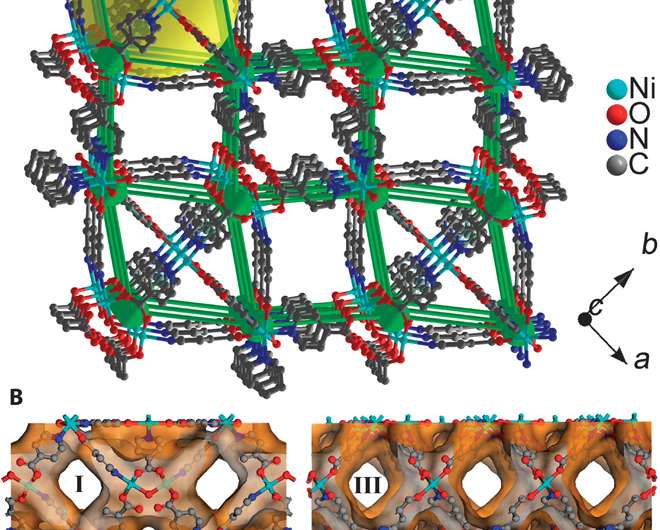December 21, 2015 report
Researchers propose new kind of MOF to clean coal burned in power plants

(Phys.org)—A small team of researchers with members from India, Canada, the U.S. and Germany has come up with a new kind of metal-organic framework (MOF) to keep carbon in coal from entering the atmosphere when it is burned in power plants—thus reducing pollution and problems with global warming. In their paper published in the journal Science Advances, the team describes their new technique, and what hurdles need to be overcome for it to be used in commercial plants.
As the researchers note, most of the effort currently put into making coal a cleaner fuel source revolve around capturing the carbon dioxide that is released when coal is burned. They suggest a better alternative might be to separate out the carbon dioxide as part of the burning process, leaving clean hydrogen gas as the actual fuel used to heat water to turn turbines.
The new MOF proposed by the team involves the use of nickel and isonicotinic acid as a sponge to pull the carbon from the coal. It would be part of a process that involves burning the coal with steam under cycles of high and low pressure. They claim their approach is twice as efficient as other sponge methods and that it is also simpler, faster to make and is not harmed by moisture, making it easy to store and transfer materials.
The big catch with the process is what to do with the carbon dioxide that is separated out—capturing it, holding on to it, transporting it and ultimately storing it would represent a substantial cost outlay for any given utility, which at this point, would appear to be prohibitively high for plants that are attempting to keep electricity costs down in places where locals could not afford higher rates, such as is the case in parts of India, China and many third-world countries.
In speaking with the press, one of the researchers, Ramanathan Vaidhyanathan, suggested that this might be an issue to be brought before an international forum such as the recent Paris Climate Change Conference. He notes that rather than storing the carbon dioxide, it might be used in industrial applications, such as oil extraction or for creating new compounds.
More information: S. Nandi et al. A single-ligand ultra-microporous MOF for precombustion CO2 capture and hydrogen purification, Science Advances (2015). DOI: 10.1126/sciadv.1500421
Abstract
Metal organic frameworks (MOFs) built from a single small ligand typically have high stability, are rigid, and have syntheses that are often simple and easily scalable. However, they are normally ultra-microporous and do not have large surface areas amenable to gas separation applications. We report an ultra-microporous (3.5 and 4.8 Å pores) Ni-(4-pyridylcarboxylate)2 with a cubic framework that exhibits exceptionally high CO2/H2 selectivities (285 for 20:80 and 230 for 40:60 mixtures at 10 bar, 40°C) and working capacities (3.95 mmol/g), making it suitable for hydrogen purification under typical precombustion CO2 capture conditions (1- to 10-bar pressure swing). It exhibits facile CO2 adsorption-desorption cycling and has CO2 self-diffusivities of ~3 × 10−9 m2/s, which is two orders higher than that of zeolite 13X and comparable to other top-performing MOFs for this application. Simulations reveal a high density of binding sites that allow for favorable CO2-CO2 interactions and large cooperative binding energies. Ultra-micropores generated by a small ligand ensures hydrolytic, hydrostatic stabilities, shelf life, and stability toward humid gas streams.
Journal information: Science Advances
© 2015 Phys.org


















